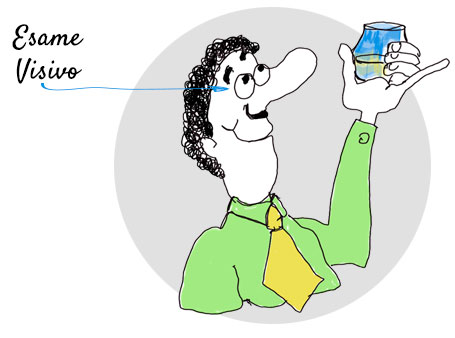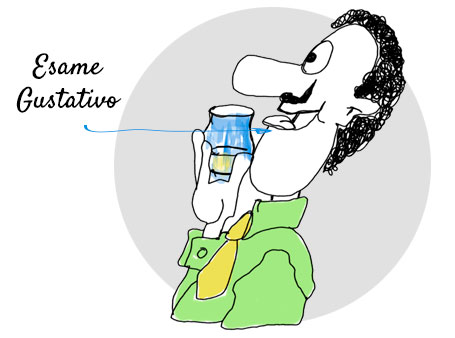Olive oil tasting
Recognizing an olive oil means knowing how to choose and value it.
The origin does not mean quality, because an olive oil is good when subject to a careful selection of the cultivars and when the mild climate stimulates its production.
In order to obtain a perfect oil we use only healthy olives, grown in well-irrigated olive groves and defended by the attack of pests.
Collected directly from the plant, the olives are subjected to a milling process, which takes place within twenty-four hours, to then proceed with the extraction of the oil
The cold extraction process below 27C ° gives the extra virgin olive oil all the natural and nutritional properties contained in the fruit, and the exclusive aromas, typical of the territory.
The organoleptic properties of our extra virgin olive oil make it a genuine product, a fundamental part of the Mediterranean diet.
The Taster

Visual evaluation
The color of the oil is not considered in the official panel test and may be green or yellow, depending on many parameters, like the olive and the degree of ripeness. However, with an examination, we can find more or less the presence of impurities in the sample.
The color of olive oil is due to chlorophyll and anthocyanins, two pigments that do not determine the taste of the oil; therefore there may be a green oil with a bad taste, or a high quality oil with a yellow / gold color and green reflections.
It is advisable not to smoke 30 minutes before tasting and not to eat very savoury foods.

Sensory evaluation
After pouring the olive oil into the glass, hold it between your hands to increase the temperature and to bring out the aromas.
High quality oils have fresh and "green" hints, defined as fruity, which can be light or intense. There may be hints of fruit (apple, almond or dried fruit) or vegetables such as tomato, artichoke or even herbaceous scents / olive leaves.
The quality depends on the type of olives, their state (healthy olives) and their cleanliness before entering the mill.
Low quality oils are rancid, have mould and unpleasant flavours.

Taste evaluation
Bring the glass to your mouth and release a small amount of oil over the tongue, inhaling a little air with your mouth while keeping your lips tight (stripping), thus distributing the oil over the palate to oxygenate it.
You feel a bitter sensation and then a pleasant spicy sensation at the back of the throat that derives from the cultivar and the freshness of the olives (green olives).
The high quality oil generates a mix of flavours with the use of only few drops and is essential for the daily nutrition.
Low quality oils do not present particular aromas and are often chemically corrected; these are an unhealthy product for your diet. Be aware and support the Italian agriculture.
Olive oil.
A must-have for your kitchen
Knowing how to match the olive oil with a particular dish is an art.
Extra virgin olive oil is suitable for salads, bruschetta, meat, fish, legumes, soups, pasta and on a simple slice of bread.
Depending on the blend or monocultivar oil and the harvest period, the olive oils are classified as light, medium or intense fruity.
When frying, two elements are very important: the smoke point, that is, the temperature at which an oil begins to produce a smoke, and the critical temperature, that in which fats release harmful substances.
The smoke point of cooking oil varies according to the percentage of acidity.
The critical temperature depends on the composition of the oil and the quantity of polyunsaturated fatty acids.
Olive oil withstands high temperatures without burning, at around 180 ° C., and its critical temperature is much higher than the usual frying temperature.
When frying, olive oil keeps its nutritional properties unchanged and does not cover the taste of food, making a dry and crispy fried.

